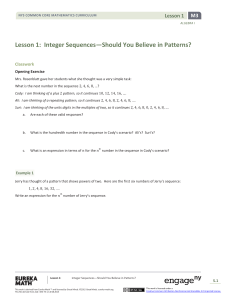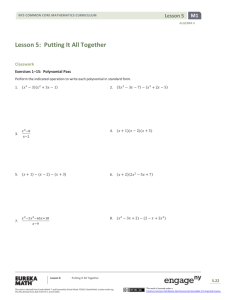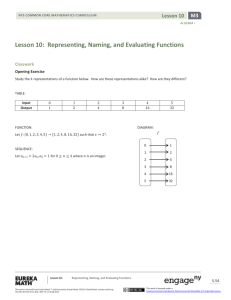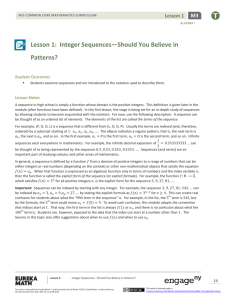Lesson 1: Integer Sequences—Should You Believe in
advertisement
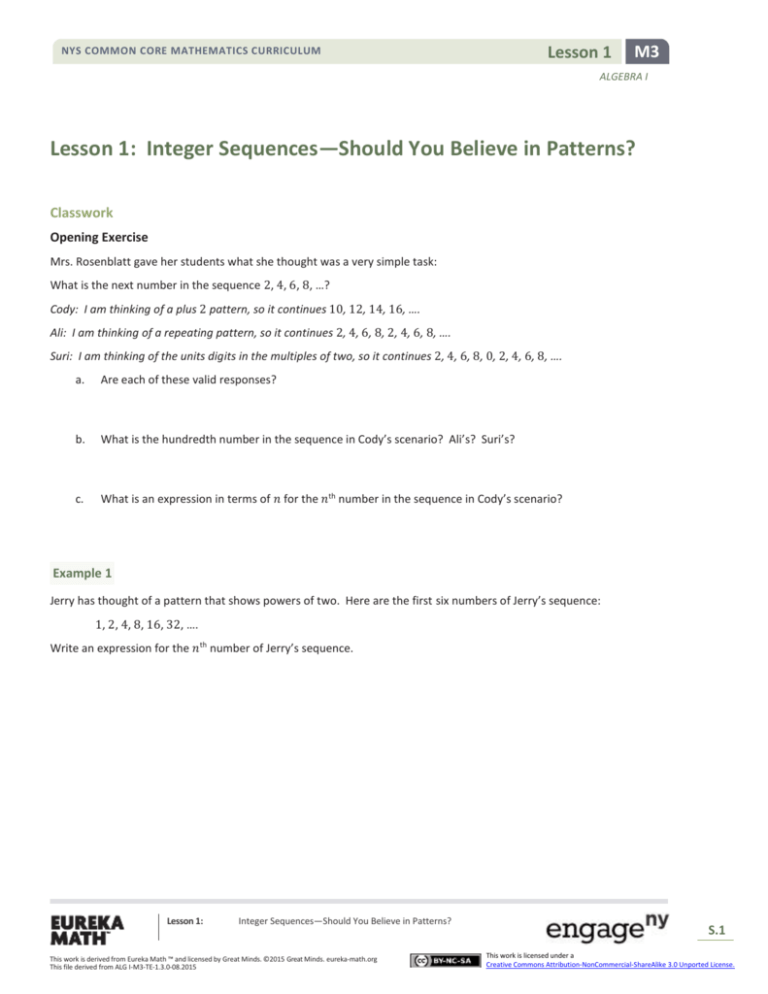
Lesson 1 NYS COMMON CORE MATHEMATICS CURRICULUM M3 ALGEBRA I Lesson 1: Integer Sequences—Should You Believe in Patterns? Classwork Opening Exercise Mrs. Rosenblatt gave her students what she thought was a very simple task: What is the next number in the sequence 2, 4, 6, 8, …? Cody: I am thinking of a plus 2 pattern, so it continues 10, 12, 14, 16, …. Ali: I am thinking of a repeating pattern, so it continues 2, 4, 6, 8, 2, 4, 6, 8, …. Suri: I am thinking of the units digits in the multiples of two, so it continues 2, 4, 6, 8, 0, 2, 4, 6, 8, …. a. Are each of these valid responses? b. What is the hundredth number in the sequence in Cody’s scenario? Ali’s? Suri’s? c. What is an expression in terms of 𝑛 for the 𝑛th number in the sequence in Cody’s scenario? Example 1 Jerry has thought of a pattern that shows powers of two. Here are the first six numbers of Jerry’s sequence: 1, 2, 4, 8, 16, 32, …. Write an expression for the 𝑛th number of Jerry’s sequence. Lesson 1: Integer Sequences—Should You Believe in Patterns? This work is derived from Eureka Math ™ and licensed by Great Minds. ©2015 Great Minds. eureka-math.org This file derived from ALG I-M3-TE-1.3.0-08.2015 S.1 This work is licensed under a Creative Commons Attribution-NonCommercial-ShareAlike 3.0 Unported License. Lesson 1 NYS COMMON CORE MATHEMATICS CURRICULUM M3 ALGEBRA I Example 2 Consider the sequence that follows a plus 3 pattern: 4, 7, 10, 13, 16, …. a. Write a formula for the sequence using both the 𝑎𝑛 notation and the 𝑓(𝑛) notation. b. Does the formula 𝑓(𝑛) = 3(𝑛 − 1) + 4 generate the same sequence? Why might some people prefer this formula? c. Graph the terms of the sequence as ordered pairs (𝑛, 𝑓(𝑛)) on the coordinate plane. What do you notice about the graph? Lesson 1: Integer Sequences—Should You Believe in Patterns? This work is derived from Eureka Math ™ and licensed by Great Minds. ©2015 Great Minds. eureka-math.org This file derived from ALG I-M3-TE-1.3.0-08.2015 S.2 This work is licensed under a Creative Commons Attribution-NonCommercial-ShareAlike 3.0 Unported License. Lesson 1 NYS COMMON CORE MATHEMATICS CURRICULUM M3 ALGEBRA I Exercises 1. Refer back to the sequence from the Opening Exercise. When Mrs. Rosenblatt was asked for the next number in the sequence 2, 4, 6, 8, …, she said “17.” The class responded, “17?” Yes, using the formula, 𝑓(𝑛) = 2. 7 7 77 1 (𝑛 − 1)4 − (𝑛 − 1)3 + (𝑛 − 1)2 + (𝑛 − 1) + 2. 24 4 24 4 a. Does her formula actually produce the numbers 2, 4, 6, and 8? b. What is the 100th term in Mrs. Rosenblatt’s sequence? Consider a sequence that follows a minus 5 pattern: 30, 25, 20, 15, …. a. Write a formula for the 𝑛th term of the sequence. Be sure to specify what value of 𝑛 your formula starts with. b. Using the formula, find the 20th term of the sequence. c. Graph the terms of the sequence as ordered pairs (𝑛, 𝑓(𝑛)) on a coordinate plane. Lesson 1: Integer Sequences—Should You Believe in Patterns? This work is derived from Eureka Math ™ and licensed by Great Minds. ©2015 Great Minds. eureka-math.org This file derived from ALG I-M3-TE-1.3.0-08.2015 S.3 This work is licensed under a Creative Commons Attribution-NonCommercial-ShareAlike 3.0 Unported License. Lesson 1 NYS COMMON CORE MATHEMATICS CURRICULUM M3 ALGEBRA I 3. Consider a sequence that follows a times 5 pattern: 1, 5, 25, 125, …. a. Write a formula for the 𝑛th term of the sequence. Be sure to specify what value of 𝑛 your formula starts with. b. Using the formula, find the 10th term of the sequence. c. Graph the terms of the sequence as ordered pairs (𝑛, 𝑓(𝑛)) on a coordinate plane. Lesson 1: Integer Sequences—Should You Believe in Patterns? This work is derived from Eureka Math ™ and licensed by Great Minds. ©2015 Great Minds. eureka-math.org This file derived from ALG I-M3-TE-1.3.0-08.2015 S.4 This work is licensed under a Creative Commons Attribution-NonCommercial-ShareAlike 3.0 Unported License. Lesson 1 NYS COMMON CORE MATHEMATICS CURRICULUM M3 ALGEBRA I 4. Consider the sequence formed by the square numbers: a. Write a formula for the 𝑛th term of the sequence. Be sure to specify what value of 𝑛 your formula starts with. b. Using the formula, find the 50th term of the sequence. c. Graph the terms of the sequence as ordered pairs (𝑛, 𝑓(𝑛)) on a coordinate plane. Lesson 1: Integer Sequences—Should You Believe in Patterns? This work is derived from Eureka Math ™ and licensed by Great Minds. ©2015 Great Minds. eureka-math.org This file derived from ALG I-M3-TE-1.3.0-08.2015 S.5 This work is licensed under a Creative Commons Attribution-NonCommercial-ShareAlike 3.0 Unported License. Lesson 1 NYS COMMON CORE MATHEMATICS CURRICULUM M3 ALGEBRA I 5. A standard letter-sized piece of paper has a length and width of 8.5 inches by 11 inches. a. Find the area of one piece of paper. b. If the paper were folded completely in half, what would be the area of the resulting rectangle? c. Write a formula for a sequence to determine the area of the paper after 𝑛 folds. d. What would the area be after 7 folds? Lesson 1: Integer Sequences—Should You Believe in Patterns? This work is derived from Eureka Math ™ and licensed by Great Minds. ©2015 Great Minds. eureka-math.org This file derived from ALG I-M3-TE-1.3.0-08.2015 S.6 This work is licensed under a Creative Commons Attribution-NonCommercial-ShareAlike 3.0 Unported License. Lesson 1 NYS COMMON CORE MATHEMATICS CURRICULUM M3 ALGEBRA I Lesson Summary Think of a sequence as an ordered list of elements. Give an explicit formula to define the pattern of the sequence. Unless specified otherwise, find the first term by substituting 1 into the formula. Problem Set 1. Consider a sequence generated by the formula 𝑓(𝑛) = 6𝑛 − 4 starting with 𝑛 = 1. Generate the terms 𝑓(1), 𝑓(2), 𝑓(3), 𝑓(4), and 𝑓(5). 2. Consider a sequence given by the formula 𝑓(𝑛) = 1 3 𝑛−1 starting with 𝑛 = 1. Generate the first 5 terms of the sequence. 3. Consider a sequence given by the formula 𝑓(𝑛) = (−1)𝑛 × 3 starting with 𝑛 = 1. Generate the first 5 terms of the sequence. 4. Here is the classic puzzle that shows that patterns need not hold true. What are the numbers counting? a. Based on the sequence of numbers, predict the next number. b. Write a formula based on the perceived pattern. c. Find the next number in the sequence by actually counting. d. Based on your answer from part (c), is your model from part (b) effective for this puzzle? Lesson 1: Integer Sequences—Should You Believe in Patterns? This work is derived from Eureka Math ™ and licensed by Great Minds. ©2015 Great Minds. eureka-math.org This file derived from ALG I-M3-TE-1.3.0-08.2015 S.7 This work is licensed under a Creative Commons Attribution-NonCommercial-ShareAlike 3.0 Unported License. Lesson 1 NYS COMMON CORE MATHEMATICS CURRICULUM M3 ALGEBRA I For each of the sequences in Problems 5–8: a. Write a formula for the 𝑛th term of the sequence. Be sure to specify what value of 𝑛 your formula starts with. b. Using the formula, find the 15th term of the sequence. c. Graph the terms of the sequence as ordered pairs (𝑛, 𝑓(𝑛)) on a coordinate plane. 5. The sequence follows a plus 2 pattern: 3, 5, 7, 9, …. 6. The sequence follows a times 4 pattern: 1, 4, 16, 64, …. 7. The sequence follows a times −1 pattern: 6, −6, 6, −6, …. 8. The sequence follows a minus 3 pattern: 12, 9, 6, 3, …. Lesson 1: Integer Sequences—Should You Believe in Patterns? This work is derived from Eureka Math ™ and licensed by Great Minds. ©2015 Great Minds. eureka-math.org This file derived from ALG I-M3-TE-1.3.0-08.2015 S.8 This work is licensed under a Creative Commons Attribution-NonCommercial-ShareAlike 3.0 Unported License.




